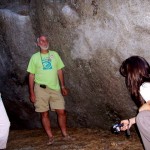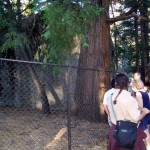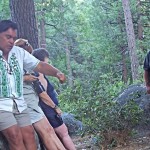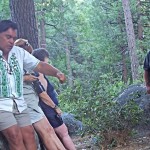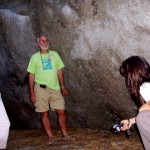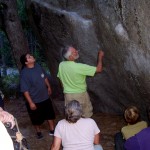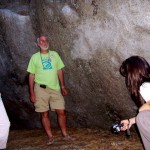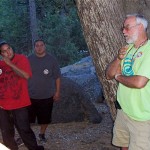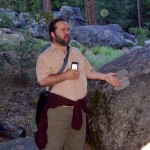By Marcia E. Gawecki
Students from the Native Plants class at Idyllwild Arts were going to look at rock paintings that were estimated to be 300 to 500 years old.
This is one of the many classes available during “Native American Arts Week” held July 10-16.
Daniel McCarthy, a Tribal Relations Manager from the U.S. Forest Service, stood next to a placard in the Idyllwild, CA, County Park, about 20 feet from a fenced-in boulder.
“This is an improvement from 40 years ago,” he said. “The fence will keep rock climbers out, but it prevents anyone from getting close.”
Daniel explained these rock paintings were not graffiti, but a sacred component of a coming-of-age ceremony by Cahuilla Indian girls.
They had created a variety of symbols with red paint, but it was difficult to determine what they all meant, but likely they were created over time.
“There may have been a ‘gap’ year or ten years,” Daniel said. “It all depended upon the acorn harvest.”
Near the rock, he pointed out several grinding stones.
The second rock painting featured two small handprints and no fence. Above, Daniel pointed out the white chalk marks.
“Here, rock climbers are practicing their skills, and below, there’s a 110-year-old rock drawing at risk,” he said.
He added that it was up to the County Parks Service employees to educate the public and warn climbers.
Abe Sanchez, their Native American co-teacher, discussed harvesting chia seeds.
“They’re high in protein, easier to digest than flax seeds, and could keep you from getting hungry,” he said.
Peg McClure, an Orange County firefighter, agreed.
“We were fighting the Laguna Fire, and didn’t have any food for about 36 hours,” Peg said. “So I chewed chia seeds and really wasn’t hungry.”
Originally, Peg admitted to taking the class for smoothies’ recipes, but has learned much more.
Even the young Cahuilla Indians were looking at native plants with new eyes.
“They’ve eaten our bad Western diet, and now have diabetes and heart disease,” said Evan Mills, another student. “Now they’re turning to their native plants for health benefits.”
The next day, the class had to cook a traditional Cahuilla meal, including sautéed nettles, acorn mush, pumpkin flowers, maze tortillas with elk sausage—and grasshoppers.
“They taste kind of nutty,” one student admitted.
The final rock painting was located three miles away in Fern Valley. The images were the most detailed and elaborate of the three, including red and black dyes.
The red dye came from hematite, an iron ore, which was ground into a powder.
“What were some of the bonding agents they could have used?” Daniel asked.
No one knew.
“Egg whites, blood, urine or any kind of animal protein,” Daniel said.
Some of the marks on the rock were more distinct, while others had faded.
“There is snow up here, so there’s natural erosion,” he said.
One time, Daniel found remnants of a campfire below the painting. He cleaned it up, and wiped the singe marks from the rock.
“Fire could cause stress to the rock, which would eventually erode the paintings,” he said.
There was no marker on this site, but Daniel said the neighbors knew about the paintings.
“With education and diligent caretaking, we can preserve this site’s cultural value for many years to come,” he said.
Copyright 2011 Idyllwild Me. All rights reserved.
Published on: Jul 13, 2011 @ 17:32

the attachments to this post:




